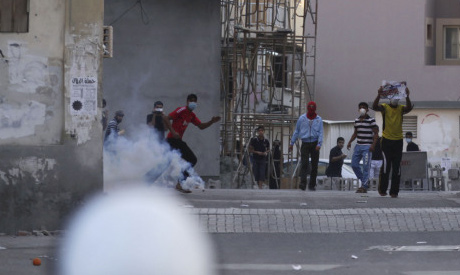
Bahraini anti-government protesters react from tear gas fired by police during clashes in Sanabis, Bahrain, Monday, Feb. 11, 2013 (Photo: AP)
In the village of Sitra, Mahmud readies himself for another evening of clashes with police, reflecting the radical turn the uprising has taken as Bahrain's political deadlock enters its third year.
"We are angry. We have no jobs and the regime must fall," the 17-year-old says as he prepares to hurl stones and petrol bombs at police at the end of an ongoing demonstration.
"We prepare the Molotov cocktails in abandoned homes to use them against the police -- our enemy," says Mahmud. "This is in self-defence. They have killed too many martyrs."
A youth around Mahmud's age died in clashes on Thursday between police and protesters commemorating the anniversary of the 2011 uprising, adding to an estimated overall toll of at least 80 people killed in two years of unrest.
Mahmud, who is masked and dressed in a brown track suit, describes Sitra as "the capital of the revolution," as do many Bahrainis.
Walls across the village southeast of Manama are covered in anti-regime graffiti such as "Down Hamad" and "Down Al-Khalifa," referring to the Sunni monarchy that has ruled Shiite-majority Bahrain for decades.
Shiite Muslim slogans and black flags virtually cover relatively poor Shiite villages surrounding the capital where protesters frequently clash with police forces.
But 19-year-old Ali insists that "we have no problem with the Sunnis. Our problem is with the regime".
Portraits of jailed opposition leaders, mainly Hassan Mashaima -- head of the Shiite movement Haq and Abdulhadi Khawaja who last year staged a 110-day hunger strike over his imprisonment -- are also plastered on walls.
Both leaders are among a seven prominent activists jailed for life for "plotting to overthrow the monarchy".
Scattered on every street is burnt garbage and remnants of tyres that had been set ablaze to block roads the night before.
Women clad in black abayas (cloaks) march waving Bahrain's red and white flag, shouting: "Allahu akbar" (God is greatest).
Gathered in front of a Shiite mosque, known as a Husainiyah, Mahmud and his comrades wait for a demonstration organised by the political opposition demanding reforms to pass.
They don't always immediately join the villagers' march. Instead, they run down to block the streets at the entrances to Sitra using rocks, tree trunks and garbage containers.
Armoured police vehicles arrive quickly and the daily cat-and-mouse chase begins.
One teenager hurls stones at the police while another drops a petrol bomb from a building. Police respond, firing tear gas, rubber bullets and shotguns.
The atmosphere across Bahrain's Shiite villages reflects the increasing radicalistion of the uprising that began on February 14, 2011.
While the main opposition led by Al-Wefaq has agreed to join a national dialogue which resumed at the weekend, the more radical clandestine February 14 Revolution Youth Coalition rejects any talks and insists on overthrowing the monarchy.
However, many people in Shiite-populated villages see no difference between both groups.
"In the afternoon, we are with Al-Wefaq," which organises peaceful demonstrations authorised by the government, says a resident who asks not to be named.
"In the evening, we respond to the February 14 Revolution Youth Coalition" calls for protest.
The kingdom, home to the US Fifth Fleet, has been in political deadlock since February 2011 with the government of Bahrain making no political concessions to the opposition.
"On February 14, 2011, we had demands," says 50-year-old Yousef Ahmad. "But now, we want victory or death."
Short link: